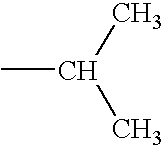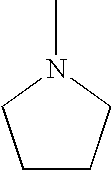Packing material for chromatography having novel characteristic and method for isolation of substance using the same
a technology of packaging material and chromatography, which is applied in the direction of other chemical processes, separation processes, instruments, etc., can solve the problems of weakened hydrophobic interaction with the hydrophobic packing, damage to the activity of the target sample, and deterioration caused by deterioration
- Summary
- Abstract
- Description
- Claims
- Application Information
AI Technical Summary
Benefits of technology
Problems solved by technology
Method used
Image
Examples
example 1
1. Synthesis of Polymer
1-1) Poly(IPAAm-DMAPAAm) (DMAPAAm:N,N-dimethylaminopropyl-acrylamide)
1-1-a) Preparation of IPAAm Copolymer Having Carboxyl End
An IPAAm copolymer having a carboxyl end was synthesized in such a manner as to give a molecular weight of 4,000 as a standard. The molecular weight of the polymer can be designed by controlling the amount of 3-mercaptopropionic acid (MPA) employed as a chain transfer agent. To prepare a copolymer having a molecular weight of 4,000, the amount of MPA was regulated so as to give a molar ratio MPA / (IPAAm+DMAPPAm) of 0.028.
The above components were fed into a polymerization tube and fixed with a rubber ring provided with a three-way stopcock. The polymerization tube was introduced into liquid nitrogen, while closing the cock, and completely frozen. Next, the cock was opened and the contents of the tube were degassed by using a vacuum pump. After closing the cock again, the polymerization tube was introduced into methanol and the sample in ...
example 2
1-2) Preparation of PIPAAm Hydrogel Surface
1-2-a) Formation of Gel Layer on Aminopropyl Silica Gel Surface
To introduce a polymerization initiator into aminopropyl silica gel, the following compounds were used.
Use was made of V-501 [4,41-azobis(4-cyanovaleric acid) (molecular weight: 280.28)] as a polymerization initiator and EEDQ [N-ethoxycarbonyl-2-ethoxy-1,2-dihydroquinoline, molecular weight: 247.30] as a condensing agent each in the amount as specified above. These compounds were reacted with aminopropyl silica gel in DMF. After bubbling N.sub.2 gas thereinto in the dark for 30 minutes, the reaction vessel was completely charged with N.sub.2 and reaction was carried out by using an N.sub.2 balloon at room temperature for 6 hours. After the completion of the reaction, the mixture was filtered and washed with DMF. Thus, the polymerization initiator:had been introduced into the surface of the aminopropyl silica gel.
1-2-b) Formation of Surface Gel Layer
Silica gel, IPAAm, DMAPAA and ...
example 3
Aspirin, salicylic acid, methyl salicylate and benzoic acid were separated under the following conditions by using columns packed with a positively charged gal (IPAAm:DMAPAAm=8: 2) and IPAAm hydrogel.
Separation Conditions
Column: (1) packed with poly(IPAAm) hydrogel-modified silica;
(2) packed with poly(IPAAm-co-DMAAAm) (8:2) hydrogel-modified silica.
Buffer: Na.sub.2 CO.sub.3 / NaHCO.sub.3.
pH=9.0.
Ionic strength=0.1 M.
FIG. 1 shows the results. Aspirin could not be separated from benzoic acid by using the column packed with the IPAAm hydrogel. In contrast, these compounds could be separated from each other by using the column packed with the positively charged gel (IPAAm: DMAPPAAm=8:2). At 10.degree. C., in particular, all of the four compounds including charged and uncharged ones could be separated from each other within a short period of time of about 20 minutes. The order of separation depended on the hydrophobicity degrees of these compounds. In the cases of salicylic acid and benzoi...
PUM
| Property | Measurement | Unit |
|---|---|---|
| Volume | aaaaa | aaaaa |
| Substance count | aaaaa | aaaaa |
| Percent by mole | aaaaa | aaaaa |
Abstract
Description
Claims
Application Information
 Login to View More
Login to View More - R&D
- Intellectual Property
- Life Sciences
- Materials
- Tech Scout
- Unparalleled Data Quality
- Higher Quality Content
- 60% Fewer Hallucinations
Browse by: Latest US Patents, China's latest patents, Technical Efficacy Thesaurus, Application Domain, Technology Topic, Popular Technical Reports.
© 2025 PatSnap. All rights reserved.Legal|Privacy policy|Modern Slavery Act Transparency Statement|Sitemap|About US| Contact US: help@patsnap.com



